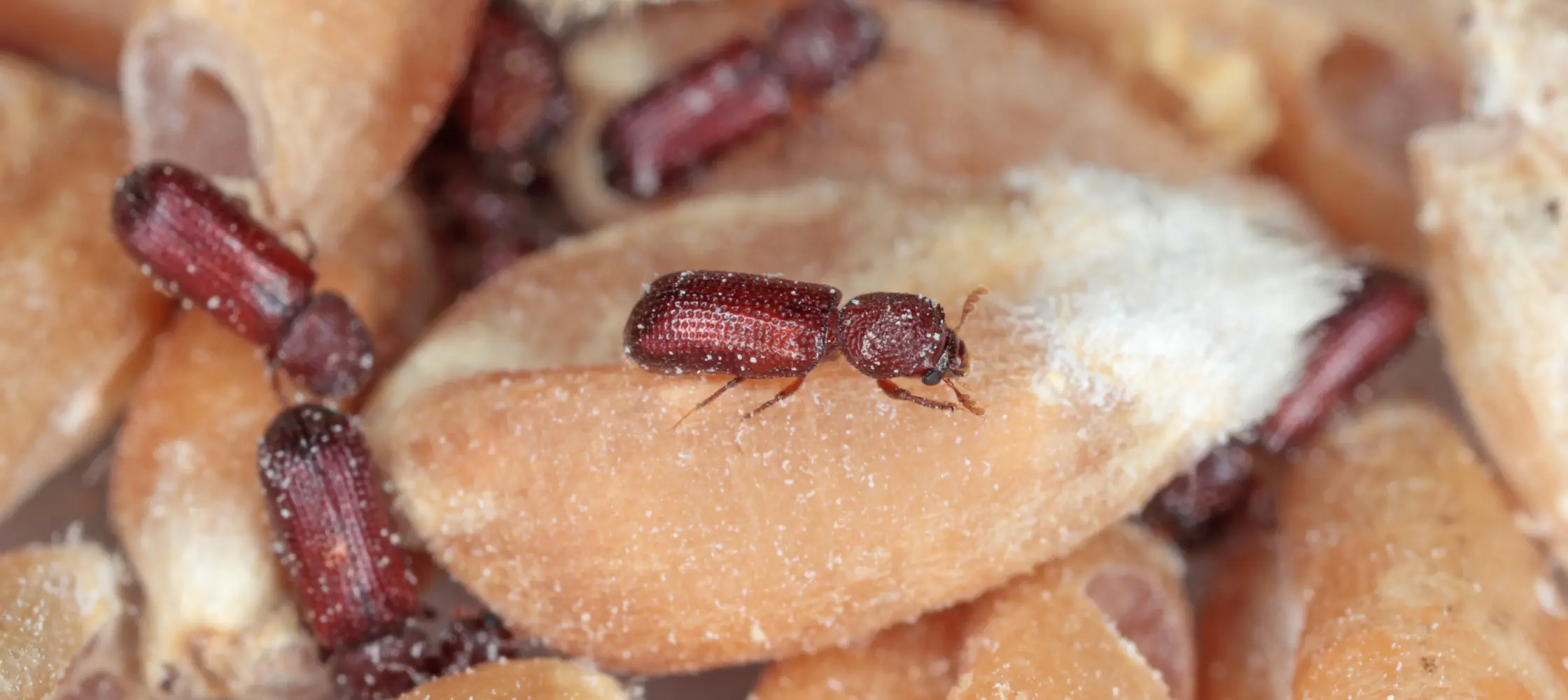
Manpreet Kaur Saini and
D.K. Sharma*
Stored grain insect pests are a serious concern for farmers who store their produce for seed, consumption or marketing purposes. There are varieties of insects which contaminate the stored food products and contribute to post-harvest losses. Total post-harvest losses are around 9.33%, whereas collaborative losses due to insects, rodents, moisture/micro-organisms, and birds are around 6.58%, while only insects contribute 2.55% post-harvest losses. Along with biotic factors like insects, rodents, birds, microorganisms etc., there are various abiotic factors like temperature, moisture, relative humidity and storage structures, which also contribute to storage losses. The weather conditions from the month of May to October were found to be most suitable for the fast multiplication of insects. There are nearly, 20 species of insect pests have been reported in Punjab, those causing heavy storage losses. These insect pests are divided into two categories: Primary insects that feed on sound/healthy grains and secondary insects that feed on milled products. They cause significant losses to stored products in terms of grain damage and weight loss by making holes, eating endosperm, making powder, webs in cereals, pulses, oil seeds, and milled products and finally affecting the nutritive value of the products. The important insect pests of stored grains found in Punjab include:
Primary insect-pests:
- Lesser grain borer: Adult and grub attacks on wheat, rice and maize. Grub feeds on waste flour and adult feeds on healthy grains
- Khapra beetle: Grub attacks on wheat, rice, maize, jowar, pulses and oilseeds. It feeds externally and damages the whole grain.
- Rice weevil: Adult and grub attacks on wheat, rice and maize. Adults make holes in the grains and grub feeds on the starchy content of the grains.
- Pulse beetle: Grub attacks on all whole pulses and bores inside the grain, eats out its contents and pupates inside it.
- Angoumois grain moth: Larvae attacks on rice, maize, jowar, barley and wheat. It bores into the grain and feeds on its contents. As it grows, it extends the hole, which partly gets filled with pellets of excreta.
Secondary insect-pests:
- Rust red flour beetle: Adult and grub damage the broken grains, milled products, flour and the germ portion of the healthy seeds. Heavy infestation in flour causes a stinking odour, which adversely affects the quality
- Rice moth: The larvae attack rice, jowar, other millets, pulses, processed products, oilseeds, nuts and milled spices. Young larvae feed on broken grains and then web these food grains with faecal matter.
- Saw-toothed beetle: Adults and grubs attacks on wheat, barley, rice, sorghum, bajra, milled products, dried fruits and animal feed. They can only feed on broken grains and grub preferentially fed on the germ portion of grains.
Pic: Damaging symptoms of stored grain insect-pests
Lesser grain borer in wheat
Red rust flour beetle in rice
Pulse beetle in moong grains
Pulse beetle in Kabulichanna
Management strategies to protect stored grains from insect pests: One of the most effective methods still used worldwide as the grain protection measure against storage insect pests is fumigation. The fumigation method has been used all over where the grains are stored for domestic, commercial, and seed purposes around the year. However, it is always advised to use integrated pest management strategies which include:
Preventive measures:
- Plugging of all cracks, crevices and holes in the godowns with mud or cement.
- Thoroughly cleaning and sweeping of godowns sweepings should be destroyed by burning or burying deep in the soil.
- Clean, sort and dry the grains before storage.
- New grains should be stored in clean godowns or receptacles.
- Do not mix new grains with old stock as later on it may get infested with insects.
- The stores should be damp proof and there should be no leakage or seepage.
- Metal bins/drums should also be cleaned properly and should be kept in the sun for 2-3 days before filling the grains.
- Grains meant for storage should be dried properly and moisture content not be more than 9%.
- Bins should be filled to their full capacity and the lid should be tightened properly.
- Use new gunny bags for storing grains meant for consumption.
- Empty godowns should be disinfested with 100ml of Cythion 50 EC(Malathion premium grade) in 10 litres of water on the floor, walls and ceiling. The spray should be done on the floor, walls and ceiling or fumigate the godowns with 25 tablets of aluminium phosphide per 100 cubic metres of empty space before storing the grains. The exposure period should be 7 days. In case, there is infestation of khapra beetle, then use a double dose of aluminium phosphide.
- Cover the stored pulses in bulk with a 7 cm layer of sand, sawdust or dung ash to protect it from pulse beetle (Dhora).
Curative measures:
Fumigation of stores can be done by using Phostoxin Delicia or Celphos (aluminium phosphide) one tablet of 3 g/tonne of grains or 25 tablets/100m3 space. The exposure period of these fumigants is for 7 days.
Whenever we use chemical insecticides, there is a need to follow precautions as aluminium phosphide is a highly poisonous gas that, if used inappropriately leads to death. Always air-tight the room or cover the produce with tarpaulins properly after using aluminium phosphide. Avoid its use in the drum or godowns near living areas.
Writers are from the Department of Processing and Food Engineering, Department of Entomology
Email: dksharma134@pau.edu Mob: 9872623033
Your email address will not be published. Required fields are marked *
29 Jan, 2024
29 Jan, 2024
29 Jan, 2024
25 Jan, 2024